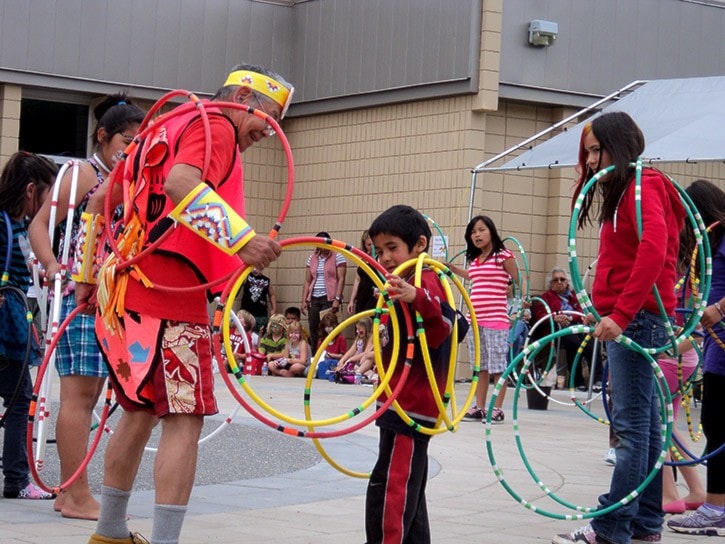One of the spectacular events at the 2012 National Aboriginal Day celebration at Thompson Rivers University was hoop dancing, performed by young people from several local First Nations communities.
The colourful, energetic dances were orchestrated and organized by local resident Francis Johnson — the first time kids from three separate bands came together to share the gift of traditional dance with their communities.
Born in Williams Lake and raised in Alkali Lake, Francis Johnson Sr. said that his interest in hoop dancing began when he started teaching traditional dance, such as ‘Grass’ and ‘Fancy’ dances to kids in Canoe Creek in 2005.
He said that he brought in dancers for the kids to watch, and had help from his daughters with drumming and dance steps. “I’d show the kids some moves,” he said. He also taught dancing and drumming to kids from the Red Bluff and Kluskus communities for three years.
“After that, some of my Canoe Creek students went to Sugarcane where international champion hoop dancer Dallas Arcand offered a workshop, and when those kids came back to Canoe Creek, they made hoops and they taught me.
“I was clumsy at first, but the kids helped me out and after a lot of practice I got better.”
He said that it was while pursuing his education at UBC—receiving both a BA and an MA in education, that he realized the powerful importance of cultural dancing in First Nations communities.
“Pow wows weren’t part of our culture, and neither is this kind of dancing. We did more barn dancing,” he said. “We borrowed dance styles, such as the Fancy Dance and the Grass-style dancing, and the elders said it was OK. We had people from the prairies come and teach our people dancing and it was passed from one generation to the next. Hoop dancing originated in the US—they used willow sticks tied together, decorated and painted.”
He explained that as soon as the kids taught him some hoop dancing, people slowly began to embrace it. “The kids wanted to dance, the parents wanted to encourage them, and I worked with the families to support it. With some basic skills, the kids designed and built their own hoops.”
He said that after he successfully auditioned in the Gibraltar Room for the Olympic Torch Ceremony in Williams Lake, he was asked to teach dance at Nemiah.
“I taught 18 hoop dancers, with the help of my daughters,” he continued. “With the support of community members from Nemiah and Alkali Lake, we made hoops and fancy dance outfits, including vests and aprons, for all the kids.”
After Nemiah he went to the Anaham Band and helped teach hoop dancing to 30 people. “The Tsilhqot’in people are a very proud race with many different skills, and I encouraged them to learn and embrace their culture,” he said. “I also learned a few words in Tsilhqot’in.”
At National Aboriginal Day at Thompson Rivers University this summer, he danced with young people from Nemiah, Alkali Lake and Anaham Indian Bands.
“They all did their own dances and then I put them together for a grand finale—the first time this has happened,” he stated.
He added that his goal, from the beginning was to have kids from different bands dance together.
“There is natural mentoring between the older kids and the younger ones. I always encourage kids to understand their culture and understand themselves—something that builds their self-esteem and their confidence,” he said.
“You see big improvements in the kids. Sometimes they don’t want to perform at all, and after that first time they are a lot more comfortable. I always invite all the kids to join in the hoops for some cross-cultural sharing.”
He said that you have to be in shape to dance, and leads by example – jogging five miles three times a week to stay fit.
“It also takes practice to get all the different moves,” he explained. “I create high expectations for the kids. If you want to be a hoop dancer, you have to practice and practice.
“I teach them to respect their hoops and respect each other when they’re dancing: this is so important for kids.”
Francis is married with six children—his wife is a skilled dance regalia maker, his daughters are beaders, dancers, drummers and singers, one of his sons is an excellent dancer and one plays hockey with the Stampeders.
He said that his family takes great pride in First Nations culture and history, and added that two of his grandchildren are beginner dancers.
He said he’d like to see more bands and more kids get involved in more dance performances. “My goal is eventually to leave this gift for our kids,” he said. “When you’re dancing you bring joy to people.”
